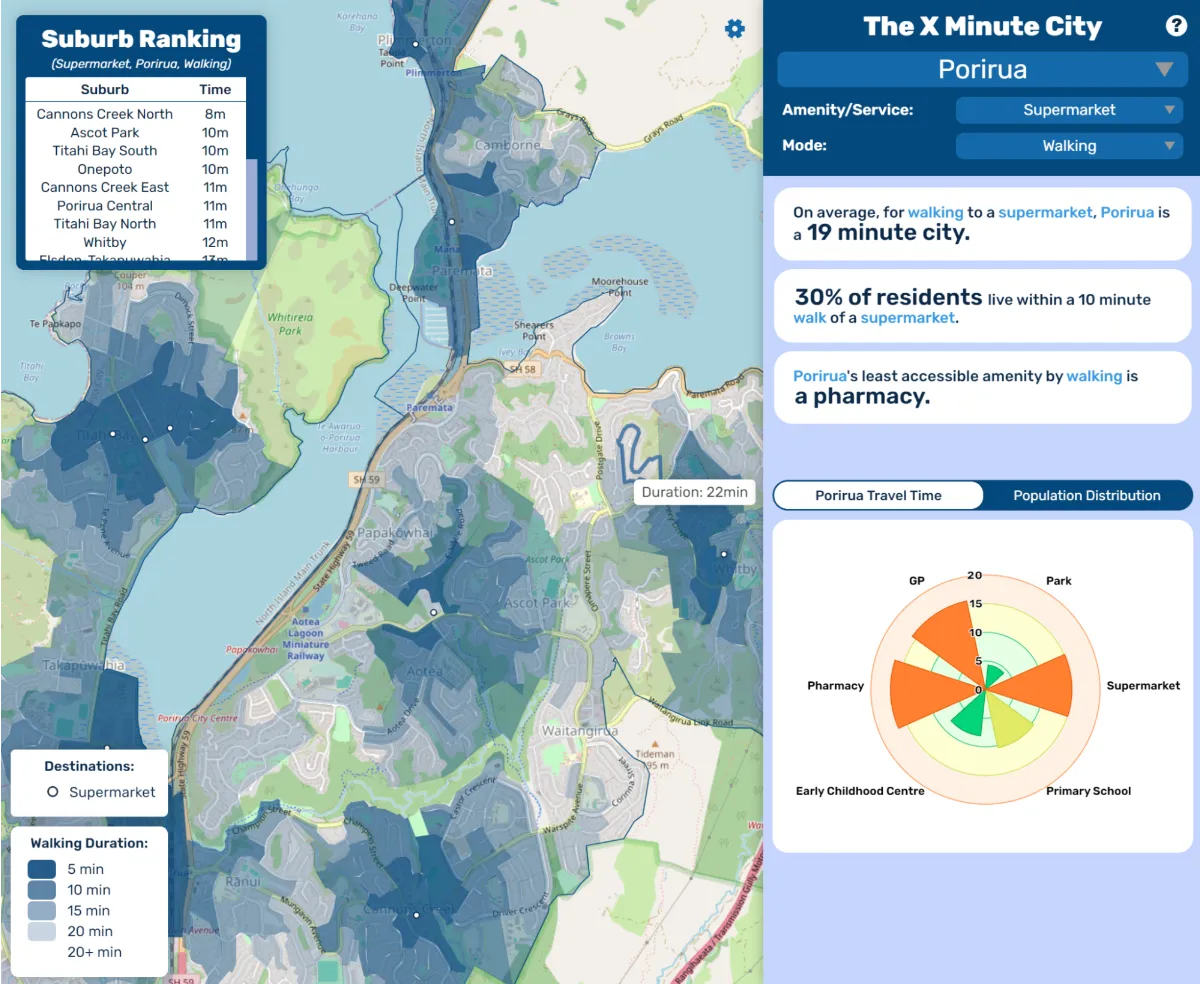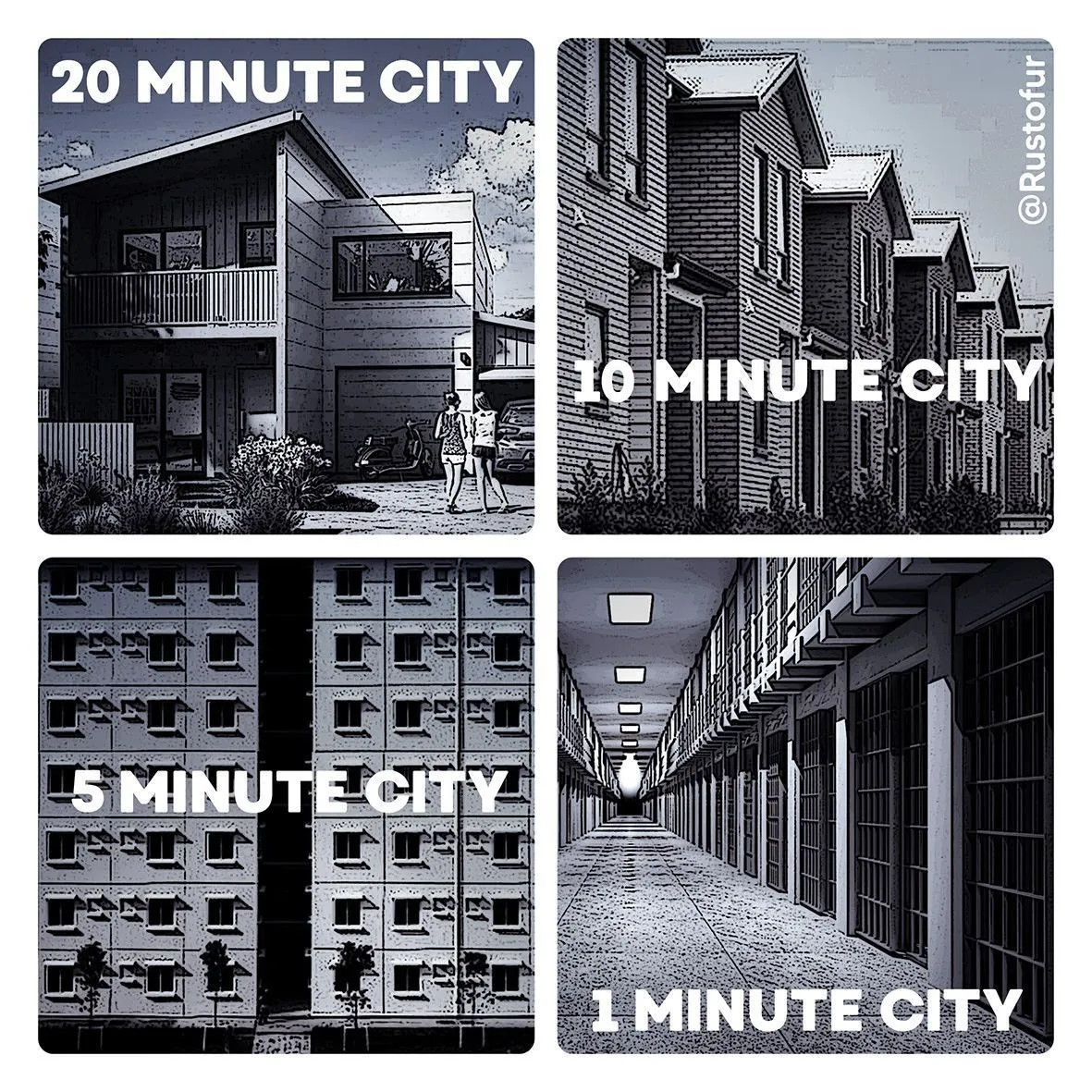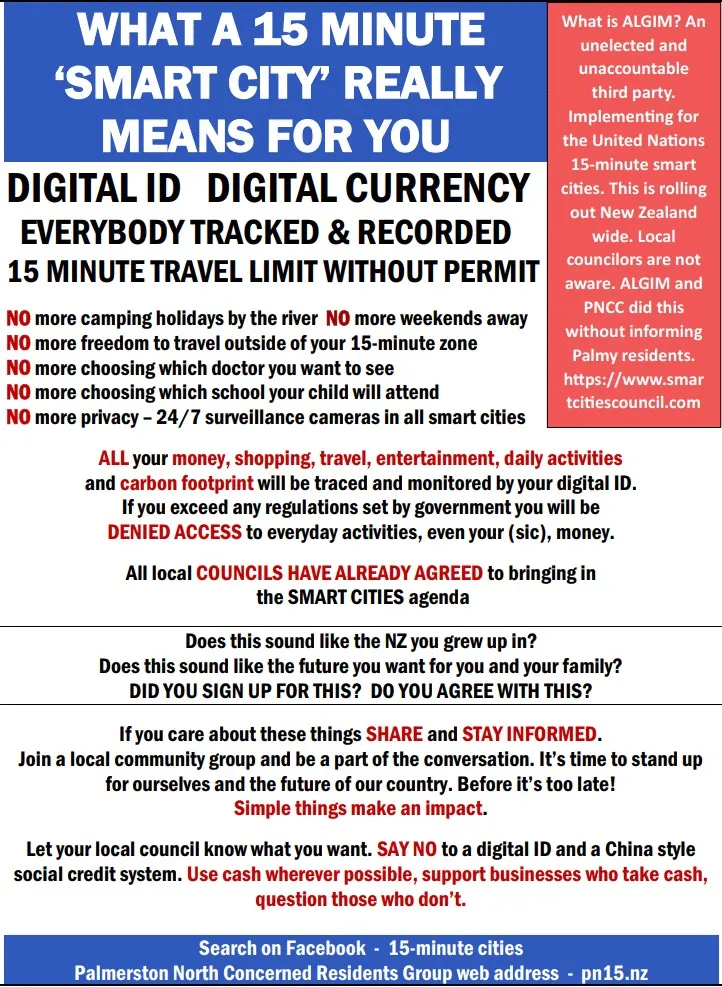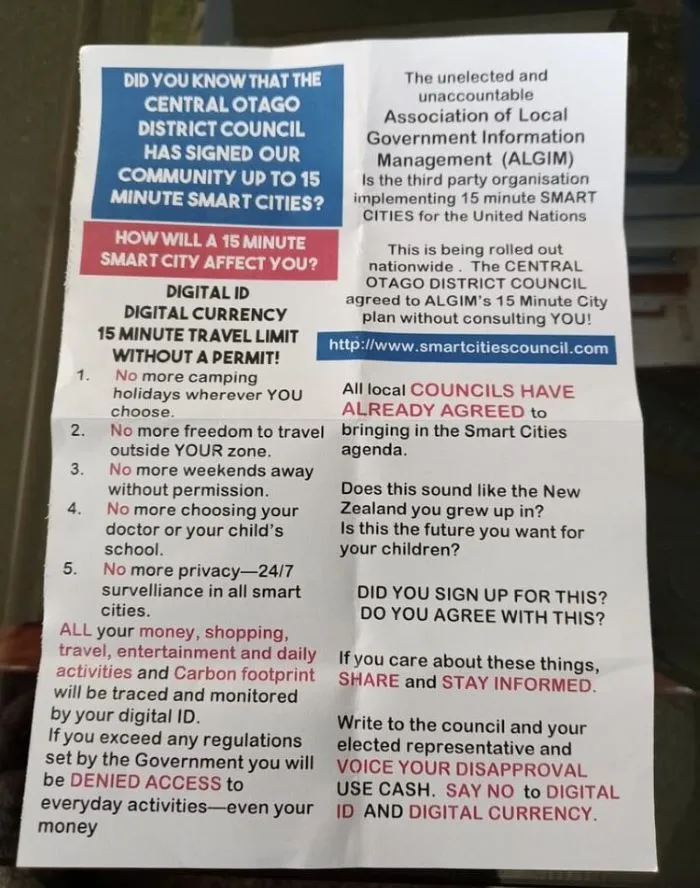15 Minute Cities
Mark Honeychurch - 11th December 2023
Many of you, as skeptics, will have heard mention of 15 minute cities and, in our case, because New Zealand likes to be different, 20 minute cities. The 15 Minute City idea has joined Agenda 21, Agenda 2030 and the Great Reset in the pantheon of recent Big Ideas that actually exist, but have been converted by conspiracy theorists into grotesque versions of themselves where governments are supposedly trying to take away our rights and enslave us all. But, what is the idea of a 15/20 minute city, and how have the conspiracy theorists misrepresented the idea?
The Reality
The concept of a 15 minute city has gained popularity since the beginning of the pandemic, although there are precursors going all the way back to the 1920s with Clarence Perry, an urban planner in the US, and his idea of a “neighbourhood unit”. With increasing urbanisation, and the domination of cars as a form of transport, we’ve seen a centralising of shops, restaurants, entertainment venues and other amenities. Inspired by some of the issues we faced around the world during the early days of the pandemic, urban planners started to look at the idea of moving all our essential services (shops, healthcare, education and social activities) to within a 15 minute walk or bicycle ride of the homes of the people who would use these services.
Locally, Hamilton council has been looking into the possibility of implementing a 20-Minute City. The chair of the council said back in 2020:
“In its simplest terms, it’s about linking existing destinations with walking, cycling and public transport connections, creating a city which means most residents can safely access most of the things they need within 20 minutes, without relying on private vehicles”
The council even touts some lofty potential benefits that sound a little more aspirational than practically achievable, although if they can manage all of this I will be impressed:
“Financial barriers to connectivity would be reduced or removed. People could access neighbourhood parks, shopping centres, schools or workplaces safely and quickly. Fully-separated cycleways and pedestrian networks would mean parents are happy to let their children bike, scooter or walk to school, reducing weekly vehicle movements in the city by tens of thousands. Air quality would be improved as Hamiltonians make the choice to reduce single-occupant vehicle trips and in turn this would reduce the heavy-metal pollutants from stormwater runoff for our waterways.”
Last year news website “The Conversation” looked at how accessible New Zealand’s cities already are for walking to local amenities, and found that Wellington, Napier and Palmerston North are already fairly well aligned with the 15 minute city concept, although we still apparently fall behind many other cities around the world. There’s a really nice interactive map from Urban Intelligence if you want to explore your local area. For example, here’s a breakdown of my local area, Porirua, where I’ve chosen supermarkets as the amenity to be mapped, and walking as my mode of transport (I’ve hovered over my street, which shows that I live 22 minutes’ walk from a supermarket):

On the face of it, working towards making our amenities 15 or 20 minutes’ walk away seems like a good idea, at least in principle. Practically there may be issues around retrofitting existing suburbs to fit the model, as well as shoehorning enough houses within geographies that don’t lend themselves to creating a neat, circular, easily traversable suburb (especially for the elderly and others who have problems travelling), like the hillier parts of Wellington or Dunedin. But, for many places around the world, the idea of reducing dependence on car transport by building a suburb around delivering essential services close by does seem to have some merit.
For an interesting, nuanced discussion about 15 minute cities, here’s a nearly two hour video from Christchurch where local residents, council members, academics and town planners talk about changes that could be made.
The Fiction
There doesn’t seem to be a well-meaning idea that conspiracy theorists can’t twist into something nefarious and underhanded, and 15 minute cities are no exception. In the UK, even parts of the government appear to have jumped on the bandwagon, with MPs spouting scaremongering nonsense.
The main claim being made is that the real, unspoken reason governments and councils want to implement 15 minute cities is because it will allow them to have tighter control over our movements. Over time travel outside of our 15 minute radius will be discouraged, and then eventually outlawed, effectively making us prisoners within our community bubbles. This conspiracy seems to have ballooned since early this year, and some outlandish claims have been made about the impending loss of our freedoms. The most extreme I’ve seen so far is that the Hawaiian wildfires were actually caused by an energy weapon in space (presumably the same Jewish space laser that was used to create wildfires in California), and that the city of Lahaina was burned down intentionally to make way for a new 15 minute city.
It’s hard to track the genesis of this conspiracy, but it seems that both the Heartland Institute (via their climate denying “Watts Up With That” blog) and Jordan Peterson were in on the game fairly early on, as was UK Conservative MP Nick Fletcher. Oxford in the UK seems to be a popular example that is used to scare people about 15 minute cities, with a proposed idea to reduce urban traffic on congested roads by restricting how people drive between suburbs, pushing drivers onto a ring road if they wish to cross to another suburb.
For “balance” to the nearly two hour, well-informed Christchurch video above, here’s a minute and a half rant from Brian Tamaki, where a full half of the video is just a clip of Jordan Peterson talking:
Looking to New Zealand, Voices for Freedom leapt on the idea of 15 minute cities being a conspiracy earlier this year, saying in a June newsletter:
_Over the weekend a news article heralded the announcement of a series of new 20-minute cities in the North Island. Kiwi Property Group plans to expand the scope of Sylvia Park in South Auckland to become a “multifunctional hub where work, home, shops, entertainment, and healthcare will all be accessible by foot, bike, or public transport.” Other regions with similar plans include New Lynn in West Auckland and Hamilton.
On the surface, this all sounds great. Imagine having everything you need within an easy walk or ride. Leave the car at home and save money on gas. Maybe even get better connected with those in your community. Awesome!
This kind of community connectedness is what VFF has been promoting since we began. So, aside from the ‘build-to-rent,’ sardine-like people-farming housing developments, what’s the issue?
Well, there are a few red flags concerning us here at VFF:_
- The problematic climate narrative underpinning the ‘need’ for these developments.
- Overseas experience with ultra-low emission zones and the monitoring and restricting of people’s movements.
- The pattern of mission creep we have all lived through over the past three years during the Covid saga. We were labelled ‘conspiracy theorists’ for suggesting the government would seek to impose vaccine mandates months before they implemented them with tyrannical enthusiasm. Critical thinkers will be wary of promises regarding the curtailment of freedoms and the reframing of restrictions.
- The global march to develop, introduce, and enforce the use of Central Bank Digital Currencies (CBDCs) and the potential for using such technology to control human behaviour.
- Similar developments with Universal Basic Income (UBI) schemes fostering reliance on government handouts for survival.
- How NZ authorities could use initiatives like the WHO’s new Digital Covid Certificate and the Chinese social credit system to drive compliance in the NZ context.
The article also included this helpful image, showing how a 20 minute city where you are confined to your neighbourhood might lead to a 10 minute city where everyone is housed in terraced houses, then a 5 minute city where people live in grey apartment blocks and finally the 1 minute city where everyone is assigned a jail cell:

VfF ended their article saying:
These are areas we remain committed to continue exploring, investigating, and discussing over the coming months.
There was silence on the topic over the next few months from Voices for Freedom, until a newsletter from a week ago said that local talks have recently been given by some of their members on 20 minute cities:
Dean Harris (Regional Coordinator for Wellington) and VFF members Helena and Sarah have been touring the Western North Island, presenting to the public on CBDCs and 20 Minute Cities. This is part of a project named ‘Operation Go Large’, which seeks to educate the broader public on crucial issues we face. This tour included Palmerston North, Wanganui, Hawera (South Taranaki) and New Plymouth. Go, team!
The talks seem to be additionally covering Central Bank Digital Currencies (CBDCs) - another idea that’s been turned into a conspiracy theory (although there do seem to be some legitimate concerns about the potential for government monitoring overreach if a centralised digital currency is used).
Elsewhere, in response to Palmerston North Council talking about the possibility of implementing some of the 15 minute city ideas, one enterprising activist has created a website, PN15.nz, where they warn of the dangers of making Palmerston North more accessible to pedestrians. They “ask” many scaremongering questions, including:
“In order to travel to another part of the city to visit relatives or friends, or to shop at a preferred retailer, or visit a preferred medical centre for example, or gym, will there be a need to apply and pay for a pass?”
They’ve also made a handy warning poster that appears to a higher density of misrepresentations and outright falsehoods than I’ve seen in a long time:

An eerily similar leaflet was dropped in mailboxes in Central Otago a few months ago, claiming that the Central Otago District Council had already signed the community up to a 15 minute city program run by ALGIM:

The Otago Daily Times picked up on this story, and talked to the council. They reported that:
“Central Otago District Council group manager community vision Dylan Rushbrook said the council was not part of the Smart City movement as the flyer claimed.”
I have to say, though, that although most of these claims seem to be both unlikely and undesirable, I wouldn’t mind it if camping was banned. I hate sleeping outdoors, when I own a perfectly good mattress in a climate-controlled house, and just banning camping outright would avoid the risk of me being pressured into camping by my family or, god forbid, people who consider themselves my friends.
Whatever next?
I can’t wait to hear what the next “big idea” is, and see if I can guess what the conspiracy angle will be that will cast it as an evil plot where the government is secretly eroding our rights. I’m pretty sure that, whatever I think of, I’ll be wrong, as I’m pretty much incapable of thinking up an idea that includes such improbable ideas as space lasers, 24/7 camera surveillance, and the entire population of New Zealand being placed in prison cells.